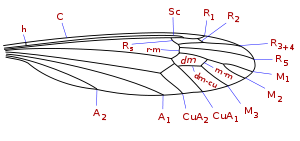Crane fly
Crane fly is a common name referring to any member of the insect family Tipulidae. Cylindrotominae, Limoniinae, and Pediciinae have been ranked as subfamilies of Tipulidae by most authors,[1] though occasionally elevated to family rank. In the most recent classifications, only Pediciidae is now ranked as a separate family, due to considerations of paraphyly.[2] In colloquial speech, crane flies are sometimes known as "mosquito hawks"[3][4] or "daddy longlegs", (a term also used to describe opiliones (harvestmen) and members of the spider family Pholcidae, both of which are arachnids). The larvae of crane flies are known commonly as leatherjackets.[3]
Crown group crane flies have existed since at least the Barremian stage of the Early Cretaceous[5] and are found worldwide, though individual species usually have limited ranges. They are most diverse in the tropics but are also common in northern latitudes and high elevations.[6]
Tipulidae is one of the largest groups of flies, including over 15,000 species and subspecies in 525 genera and subgenera.[7] Most crane flies were described by the entomologist Charles Paul Alexander, a fly specialist, in over 1000 research publications.[8]
An adult crane fly, resembling an oversized mosquito, typically has a slender body and stilt-like legs that are deciduous, easily coming off the body. The wingspan is generally about 1.0 to 6.5 cm (1⁄2 to 2+1⁄2 in), though some species of Holorusia can reach 11 cm (4+1⁄4 in).[9] The antennae have up to 19 segments.[3] It is also characterized by a V-shaped suture or groove on the back of the thorax (mesonotum) and by its wing venation. [6] The rostrum is long and in some species as long as the head and thorax together. [7]
Tipulidae are medium to large-sized flies (7–35 mm, 1⁄4–1+1⁄2 in) with elongated legs, wings, and abdomen. Their colour is yellow, brown or grey. Ocelliare absent. The rostrum (a snout) is short to very short with a beak-like point called the nasus (rarely absent). The apical segment of the maxillary palpi is flagelliform and much longer than the subapical segment. The antennae have 13 segments (exceptionally 14–19). These are whorled, serrate, or ctenidial. There is a distinct V-shaped suture between the mesonotal prescutum and scutum (near the level of the wing bases). The wings are monochromatic, longitudinally striped or marbled. In females the wings are sometimes rudimentary. The sub-costal vein (Sc) joins through Sc2 with the radial vein, Sc1 is at most a short stump. There are four, rarely (when R2 is reduced) three branches of the radial vein merging into the alar margin. The discoidal wing cell is usually present. The wing has two anal veins. Sternite 9 of the male genitalia has,with few exceptions, two pairs of appendages. Sometimes appendages are also present on sternite 8. The female ovipositor has sclerotized valves and the cerci have a smooth or dentate lower margin. The valves are sometimes modified into thick bristles or short teeth.
The larva is elongated, usually cylindrical. The posterior two-thirds of the head capsule is enclosed or retracted within the prothoracic segment. The larva is metapneustic (with only one pair of spiracles, these on the anal segment of the abdomen), but often with vestigial lateral spiracles (rarely apneustic). The head capsule is sclerotized anteriorly and deeply incised ventrally and often dorsolaterally. The mandibles are opposed and move in the horizontal or oblique plane. The abdominal segments have transverse creeping welts. The terminal segments of the abdomen are glabrous, often partially sclerotized and bearing posterior spiracles. The spiracular disc is usually surrounded by lobe-like projections and anal papillae or lobes.
.jpg/440px-Crane_Fly_-_(Tipula).jpg)


_6june2014.jpg/440px-Cranefly_molting_(3)_6june2014.jpg)
